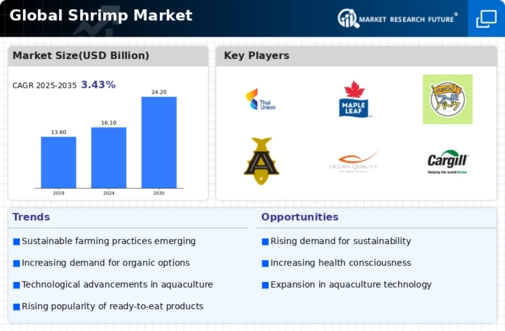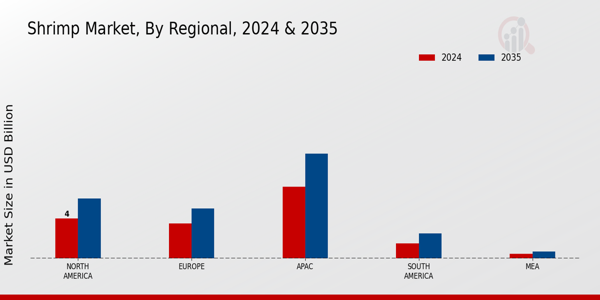Penaeus vannamei
Penaeus monodon
Metapenaeus ensis
Litopenaeus setiferus
Frozen
Fresh
Canned
Cooked
Dried
Supermarkets
Online Retail
Wholesale
Specialty Stores
Food Service
Retail
Industrial
North America
Europe
South America
Asia Pacific
Middle East and Africa
North America Outlook (USD Billion, 2019-2035)
North America Shrimp Market by Species Type
Penaeus vannamei
Penaeus monodon
Metapenaeus ensis
Litopenaeus setiferus
North America Shrimp Market by Product Form Type
Frozen
Fresh
Canned
Cooked
Dried
North America Shrimp Market by Distribution Channel Type
Supermarkets
Online Retail
Wholesale
Specialty Stores
North America Shrimp Market by End Use Type
Food Service
Retail
Industrial
North America Shrimp Market by Regional Type
US
Canada
US Outlook (USD Billion, 2019-2035)
US Shrimp Market by Species Type
Penaeus vannamei
Penaeus monodon
Metapenaeus ensis
Litopenaeus setiferus
US Shrimp Market by Product Form Type
Frozen
Fresh
Canned
Cooked
Dried
US Shrimp Market by Distribution Channel Type
Supermarkets
Online Retail
Wholesale
Specialty Stores
US Shrimp Market by End Use Type
Food Service
Retail
Industrial
CANADA Outlook (USD Billion, 2019-2035)
CANADA Shrimp Market by Species Type
Penaeus vannamei
Penaeus monodon
Metapenaeus ensis
Litopenaeus setiferus
CANADA Shrimp Market by Product Form Type
Frozen
Fresh
Canned
Cooked
Dried
CANADA Shrimp Market by Distribution Channel Type
Supermarkets
Online Retail
Wholesale
Specialty Stores
CANADA Shrimp Market by End Use Type
Food Service
Retail
Industrial
Europe Outlook (USD Billion, 2019-2035)
Europe Shrimp Market by Species Type
Penaeus vannamei
Penaeus monodon
Metapenaeus ensis
Litopenaeus setiferus
Europe Shrimp Market by Product Form Type
Frozen
Fresh
Canned
Cooked
Dried
Europe Shrimp Market by Distribution Channel Type
Supermarkets
Online Retail
Wholesale
Specialty Stores
Europe Shrimp Market by End Use Type
Food Service
Retail
Industrial
Europe Shrimp Market by Regional Type
Germany
UK
France
Russia
Italy
Spain
Rest of Europe
GERMANY Outlook (USD Billion, 2019-2035)
GERMANY Shrimp Market by Species Type
Penaeus vannamei
Penaeus monodon
Metapenaeus ensis
Litopenaeus setiferus
GERMANY Shrimp Market by Product Form Type
Frozen
Fresh
Canned
Cooked
Dried
GERMANY Shrimp Market by Distribution Channel Type
Supermarkets
Online Retail
Wholesale
Specialty Stores
GERMANY Shrimp Market by End Use Type
Food Service
Retail
Industrial
UK Outlook (USD Billion, 2019-2035)
UK Shrimp Market by Species Type
Penaeus vannamei
Penaeus monodon
Metapenaeus ensis
Litopenaeus setiferus
UK Shrimp Market by Product Form Type
Frozen
Fresh
Canned
Cooked
Dried
UK Shrimp Market by Distribution Channel Type
Supermarkets
Online Retail
Wholesale
Specialty Stores
UK Shrimp Market by End Use Type
Food Service
Retail
Industrial
FRANCE Outlook (USD Billion, 2019-2035)
FRANCE Shrimp Market by Species Type
Penaeus vannamei
Penaeus monodon
Metapenaeus ensis
Litopenaeus setiferus
FRANCE Shrimp Market by Product Form Type
Frozen
Fresh
Canned
Cooked
Dried
FRANCE Shrimp Market by Distribution Channel Type
Supermarkets
Online Retail
Wholesale
Specialty Stores
FRANCE Shrimp Market by End Use Type
Food Service
Retail
Industrial
RUSSIA Outlook (USD Billion, 2019-2035)
RUSSIA Shrimp Market by Species Type
Penaeus vannamei
Penaeus monodon
Metapenaeus ensis
Litopenaeus setiferus
RUSSIA Shrimp Market by Product Form Type
Frozen
Fresh
Canned
Cooked
Dried
RUSSIA Shrimp Market by Distribution Channel Type
Supermarkets
Online Retail
Wholesale
Specialty Stores
RUSSIA Shrimp Market by End Use Type
Food Service
Retail
Industrial
ITALY Outlook (USD Billion, 2019-2035)
ITALY Shrimp Market by Species Type
Penaeus vannamei
Penaeus monodon
Metapenaeus ensis
Litopenaeus setiferus
ITALY Shrimp Market by Product Form Type
Frozen
Fresh
Canned
Cooked
Dried
ITALY Shrimp Market by Distribution Channel Type
Supermarkets
Online Retail
Wholesale
Specialty Stores
ITALY Shrimp Market by End Use Type
Food Service
Retail
Industrial
SPAIN Outlook (USD Billion, 2019-2035)
SPAIN Shrimp Market by Species Type
Penaeus vannamei
Penaeus monodon
Metapenaeus ensis
Litopenaeus setiferus
SPAIN Shrimp Market by Product Form Type
Frozen
Fresh
Canned
Cooked
Dried
SPAIN Shrimp Market by Distribution Channel Type
Supermarkets
Online Retail
Wholesale
Specialty Stores
SPAIN Shrimp Market by End Use Type
Food Service
Retail
Industrial
REST OF EUROPE Outlook (USD Billion, 2019-2035)
REST OF EUROPE Shrimp Market by Species Type
Penaeus vannamei
Penaeus monodon
Metapenaeus ensis
Litopenaeus setiferus
REST OF EUROPE Shrimp Market by Product Form Type
Frozen
Fresh
Canned
Cooked
Dried
REST OF EUROPE Shrimp Market by Distribution Channel Type
Supermarkets
Online Retail
Wholesale
Specialty Stores
REST OF EUROPE Shrimp Market by End Use Type
Food Service
Retail
Industrial
APAC Outlook (USD Billion, 2019-2035)
APAC Shrimp Market by Species Type
Penaeus vannamei
Penaeus monodon
Metapenaeus ensis
Litopenaeus setiferus
APAC Shrimp Market by Product Form Type
Frozen
Fresh
Canned
Cooked
Dried
APAC Shrimp Market by Distribution Channel Type
Supermarkets
Online Retail
Wholesale
Specialty Stores
APAC Shrimp Market by End Use Type
Food Service
Retail
Industrial
APAC Shrimp Market by Regional Type
China
India
Japan
South Korea
Malaysia
Thailand
Indonesia
Rest of APAC
CHINA Outlook (USD Billion, 2019-2035)
CHINA Shrimp Market by Species Type
Penaeus vannamei
Penaeus monodon
Metapenaeus ensis
Litopenaeus setiferus
CHINA Shrimp Market by Product Form Type
Frozen
Fresh
Canned
Cooked
Dried
CHINA Shrimp Market by Distribution Channel Type
Supermarkets
Online Retail
Wholesale
Specialty Stores
CHINA Shrimp Market by End Use Type
Food Service
Retail
Industrial
INDIA Outlook (USD Billion, 2019-2035)
INDIA Shrimp Market by Species Type
Penaeus vannamei
Penaeus monodon
Metapenaeus ensis
Litopenaeus setiferus
INDIA Shrimp Market by Product Form Type
Frozen
Fresh
Canned
Cooked
Dried
INDIA Shrimp Market by Distribution Channel Type
Supermarkets
Online Retail
Wholesale
Specialty Stores
INDIA Shrimp Market by End Use Type
Food Service
Retail
Industrial
JAPAN Outlook (USD Billion, 2019-2035)
JAPAN Shrimp Market by Species Type
Penaeus vannamei
Penaeus monodon
Metapenaeus ensis
Litopenaeus setiferus
JAPAN Shrimp Market by Product Form Type
Frozen
Fresh
Canned
Cooked
Dried
JAPAN Shrimp Market by Distribution Channel Type
Supermarkets
Online Retail
Wholesale
Specialty Stores
JAPAN Shrimp Market by End Use Type
Food Service
Retail
Industrial
SOUTH KOREA Outlook (USD Billion, 2019-2035)
SOUTH KOREA Shrimp Market by Species Type
Penaeus vannamei
Penaeus monodon
Metapenaeus ensis
Litopenaeus setiferus
SOUTH KOREA Shrimp Market by Product Form Type
Frozen
Fresh
Canned
Cooked
Dried
SOUTH KOREA Shrimp Market by Distribution Channel Type
Supermarkets
Online Retail
Wholesale
Specialty Stores
SOUTH KOREA Shrimp Market by End Use Type
Food Service
Retail
Industrial
MALAYSIA Outlook (USD Billion, 2019-2035)
MALAYSIA Shrimp Market by Species Type
Penaeus vannamei
Penaeus monodon
Metapenaeus ensis
Litopenaeus setiferus
MALAYSIA Shrimp Market by Product Form Type
Frozen
Fresh
Canned
Cooked
Dried
MALAYSIA Shrimp Market by Distribution Channel Type
Supermarkets
Online Retail
Wholesale
Specialty Stores
MALAYSIA Shrimp Market by End Use Type
Food Service
Retail
Industrial
THAILAND Outlook (USD Billion, 2019-2035)
THAILAND Shrimp Market by Species Type
Penaeus vannamei
Penaeus monodon
Metapenaeus ensis
Litopenaeus setiferus
THAILAND Shrimp Market by Product Form Type
Frozen
Fresh
Canned
Cooked
Dried
THAILAND Shrimp Market by Distribution Channel Type
Supermarkets
Online Retail
Wholesale
Specialty Stores
THAILAND Shrimp Market by End Use Type
Food Service
Retail
Industrial
INDONESIA Outlook (USD Billion, 2019-2035)
INDONESIA Shrimp Market by Species Type
Penaeus vannamei
Penaeus monodon
Metapenaeus ensis
Litopenaeus setiferus
INDONESIA Shrimp Market by Product Form Type
Frozen
Fresh
Canned
Cooked
Dried
INDONESIA Shrimp Market by Distribution Channel Type
Supermarkets
Online Retail
Wholesale
Specialty Stores
INDONESIA Shrimp Market by End Use Type
Food Service
Retail
Industrial
REST OF APAC Outlook (USD Billion, 2019-2035)
REST OF APAC Shrimp Market by Species Type
Penaeus vannamei
Penaeus monodon
Metapenaeus ensis
Litopenaeus setiferus
REST OF APAC Shrimp Market by Product Form Type
Frozen
Fresh
Canned
Cooked
Dried
REST OF APAC Shrimp Market by Distribution Channel Type
Supermarkets
Online Retail
Wholesale
Specialty Stores
REST OF APAC Shrimp Market by End Use Type
Food Service
Retail
Industrial
South America Outlook (USD Billion, 2019-2035)
South America Shrimp Market by Species Type
Penaeus vannamei
Penaeus monodon
Metapenaeus ensis
Litopenaeus setiferus
South America Shrimp Market by Product Form Type
Frozen
Fresh
Canned
Cooked
Dried
South America Shrimp Market by Distribution Channel Type
Supermarkets
Online Retail
Wholesale
Specialty Stores
South America Shrimp Market by End Use Type
Food Service
Retail
Industrial
South America Shrimp Market by Regional Type
Brazil
Mexico
Argentina
Rest of South America
BRAZIL Outlook (USD Billion, 2019-2035)
BRAZIL Shrimp Market by Species Type
Penaeus vannamei
Penaeus monodon
Metapenaeus ensis
Litopenaeus setiferus
BRAZIL Shrimp Market by Product Form Type
Frozen
Fresh
Canned
Cooked
Dried
BRAZIL Shrimp Market by Distribution Channel Type
Supermarkets
Online Retail
Wholesale
Specialty Stores
BRAZIL Shrimp Market by End Use Type
Food Service
Retail
Industrial
MEXICO Outlook (USD Billion, 2019-2035)
MEXICO Shrimp Market by Species Type
Penaeus vannamei
Penaeus monodon
Metapenaeus ensis
Litopenaeus setiferus
MEXICO Shrimp Market by Product Form Type
Frozen
Fresh
Canned
Cooked
Dried
MEXICO Shrimp Market by Distribution Channel Type
Supermarkets
Online Retail
Wholesale
Specialty Stores
MEXICO Shrimp Market by End Use Type
Food Service
Retail
Industrial
ARGENTINA Outlook (USD Billion, 2019-2035)
ARGENTINA Shrimp Market by Species Type
Penaeus vannamei
Penaeus monodon
Metapenaeus ensis
Litopenaeus setiferus
ARGENTINA Shrimp Market by Product Form Type
Frozen
Fresh
Canned
Cooked
Dried
ARGENTINA Shrimp Market by Distribution Channel Type
Supermarkets
Online Retail
Wholesale
Specialty Stores
ARGENTINA Shrimp Market by End Use Type
Food Service
Retail
Industrial
REST OF SOUTH AMERICA Outlook (USD Billion, 2019-2035)
REST OF SOUTH AMERICA Shrimp Market by Species Type
Penaeus vannamei
Penaeus monodon
Metapenaeus ensis
Litopenaeus setiferus
REST OF SOUTH AMERICA Shrimp Market by Product Form Type
Frozen
Fresh
Canned
Cooked
Dried
REST OF SOUTH AMERICA Shrimp Market by Distribution Channel Type
Supermarkets
Online Retail
Wholesale
Specialty Stores
REST OF SOUTH AMERICA Shrimp Market by End Use Type
Food Service
Retail
Industrial
MEA Outlook (USD Billion, 2019-2035)
MEA Shrimp Market by Species Type
Penaeus vannamei
Penaeus monodon
Metapenaeus ensis
Litopenaeus setiferus
MEA Shrimp Market by Product Form Type
Frozen
Fresh
Canned
Cooked
Dried
MEA Shrimp Market by Distribution Channel Type
Supermarkets
Online Retail
Wholesale
Specialty Stores
MEA Shrimp Market by End Use Type
Food Service
Retail
Industrial
MEA Shrimp Market by Regional Type
GCC Countries
South Africa
Rest of MEA
GCC COUNTRIES Outlook (USD Billion, 2019-2035)
GCC COUNTRIES Shrimp Market by Species Type
Penaeus vannamei
Penaeus monodon
Metapenaeus ensis
Litopenaeus setiferus
GCC COUNTRIES Shrimp Market by Product Form Type
Frozen
Fresh
Canned
Cooked
Dried
GCC COUNTRIES Shrimp Market by Distribution Channel Type
Supermarkets
Online Retail
Wholesale
Specialty Stores
GCC COUNTRIES Shrimp Market by End Use Type
Food Service
Retail
Industrial
SOUTH AFRICA Outlook (USD Billion, 2019-2035)
SOUTH AFRICA Shrimp Market by Species Type
Penaeus vannamei
Penaeus monodon
Metapenaeus ensis
Litopenaeus setiferus
SOUTH AFRICA Shrimp Market by Product Form Type
Frozen
Fresh
Canned
Cooked
Dried
SOUTH AFRICA Shrimp Market by Distribution Channel Type
Supermarkets
Online Retail
Wholesale
Specialty Stores
SOUTH AFRICA Shrimp Market by End Use Type
Food Service
Retail
Industrial
REST OF MEA Outlook (USD Billion, 2019-2035)
REST OF MEA Shrimp Market by Species Type
Penaeus vannamei
Penaeus monodon
Metapenaeus ensis
Litopenaeus setiferus
REST OF MEA Shrimp Market by Product Form Type
Frozen
Fresh
Canned
Cooked
Dried
REST OF MEA Shrimp Market by Distribution Channel Type
Supermarkets
Online Retail
Wholesale
Specialty Stores
REST OF MEA Shrimp Market by End Use Type
Food Service
Retail
Industrial
















Leave a Comment